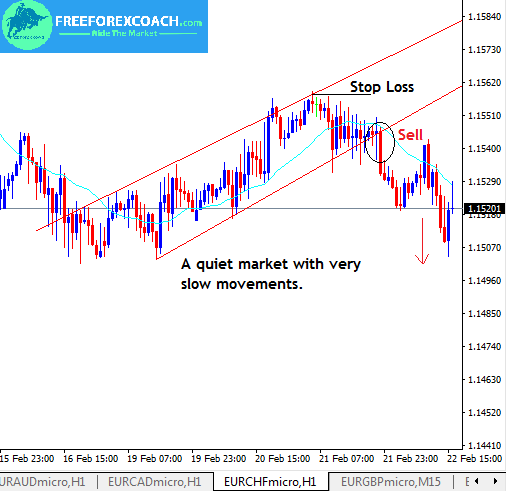There are 4 main techniques to set Stop Loss in Forex Trading. These depend on various factors in the forex market which we shall discuss later on.
Forex trading does not guarantee profits on every trade you take, you may incur losses too.
Only when you trade with stop loss, you can minimize the risk of large loss.
Now let’s look at the various ways you can set stop losses for your trades.
1. Set stop loss according to Percentage risk per trade
Once you know how much money you are willing to risk per trade,you can determine your stop loss in pips.
Your risk per trade should be consistent for all the trades you take for proper risk management. Your level of risk may also depend on the kind of a trader you are.
After getting a stop loss in pips and risk per trade, you can now determine a suitable position size for your trade.
For instance
If you are risking $20 from your $500 account per trade using a size of 10,000 units. This simply means that every pip movement is equal to $1 i.e the pip value.
Therefore the total number of pips that can match your stop loss will be (the risk amount per trade/pip value;lot size)
Which is (20*1) =20 pips. If $1 is equivalent to 1 pip then the $20 will be 20 pips.
So it will require you to set your stop loss of 20 pips below or above the entry point depending on whether you are going long or short.
2. Stop loss with Volatility.
When you consider price volatility before setting a stop loss, you study the current market conditions.
Well, this helps you to know how long a currency pair is likely to move and you will be able to determine the appropriate targets for your trade.
With a very tight stop in a very volatile market, your trade may not last even a second.
On the other hand, if you set a large stop in a less volatile market, you will be forced to use a very small size to fit your stop loss.
In the same way you are likely to set a corresponding large target which may not be hit.
As a rule of thumb, use large stops when volatility is high to allow your trades to breath. When volatility is low use small stops.
To have an appropriate risk reward your stops should be relatively connected to the target profits.
So as you intend to widen your stop loss during periods of high volatility, you should do the same for the profit target. This should also be considered when volatility is low.
In a less volatile market, your targets should not be very far from the entry because price may not be able to reach your target profits.
The common indicators used to measure volatility are:
Average True Range (ATR) indicator
ATR measures volatility.
ATR does not say anything about the trend strength or the trend direction, but it tells you how much price fluctuates.
High ATR signals that volatility is relatively high and price tends to move further within that time horizon.
The greater the ATR reading on a particular pair, the wider the stop loss you should use. The reverse is true.
Know volatility with Bollinger bands
With Bollinger bands when the bands expand, it is an indication of increasing volatility in the market. Conversely, when the bands contract, it indicates a fall in volatility.
Similarly, If price breaks on the either side of the band it indicates an increase in volatility.
However, when price stays between the bands, it’s an indication for low volatility.
Knowing the price boundaries, you will be able to choose a suitable level that is enough to keep you in the game.
You can also use the upper and lower bands to set stop loss levels. When trading with Bollinger bands, Set stop loss slightly below the lower band for a buy. Or else above the upper band for are a sell.
Learn more on how to trade with Bollinger band trading here!

3. Setting stop loss trading Chart tops and bottoms
Swing traders follow the market trends which of course form tops and bottoms as a sign of change in price momentum.
These previous highs and lows provide confluence levels on which you can rely and choose an appropriate target for stop and profit.
If the current top is lower than the previous top or the current bottom is higher than the previous one, the the previous one acts as the stop level zone.
Highs and lows usually form zones of resistance and support so traders usually place there stops on the other side of these technical levels.
Take a look at the chart below on how to set stop loss in forex using a bottom.

Price formed a bottom/low and then a new higher low.
We used the first/ previous bottom to set stop loss
But if the market volatility is low, you can use the next low before your entry point as your stop loss.
4. Setting stop depending on Time you trade
When trading Forex, it is sometimes quiet and slow or noisy with very large price movements in the market.
The market is usually quiet and slow towards the closing of the day or the opening of the first session since there are a few participants.
And it is very volatile or noisy during the release of most important economic news and the overlapping of the two trading sessions.
These quiet times are usually characterised by congestions and tight ranges. So for these times, you can use smaller stops since we have low volatility.
Volatile sessions have large movements therefore you must use wider stops.
Take a look at the EURCHF, Hourly chart below;

When you are to set stop loss in forex with time stops, you MUST consider the time you are trading in.
Trading specific sessions and time periods require different stop loss sizes.
For good risk management, always aim to fit your position size to your desired stop loss but NOT fitting stop loss to desired position size.
How Does Greed Impact your Forex Trading Success?
There are several ways greed can impact your Forex trading success. Firstly, greed can make you abandon your well crafted trading strategy in favor of impulsive and speculative actions. Instead of adhering to predetermined entry and exit points based on technical or...
-
- Topic
- Voices
- Last Post



